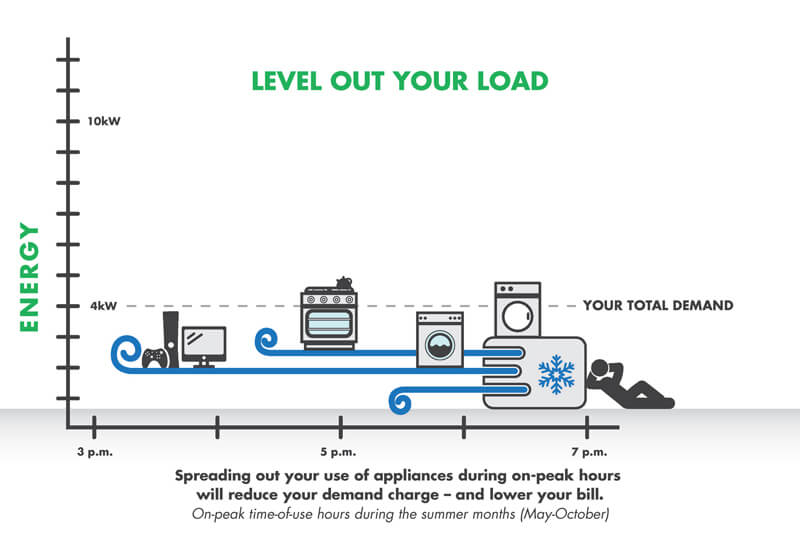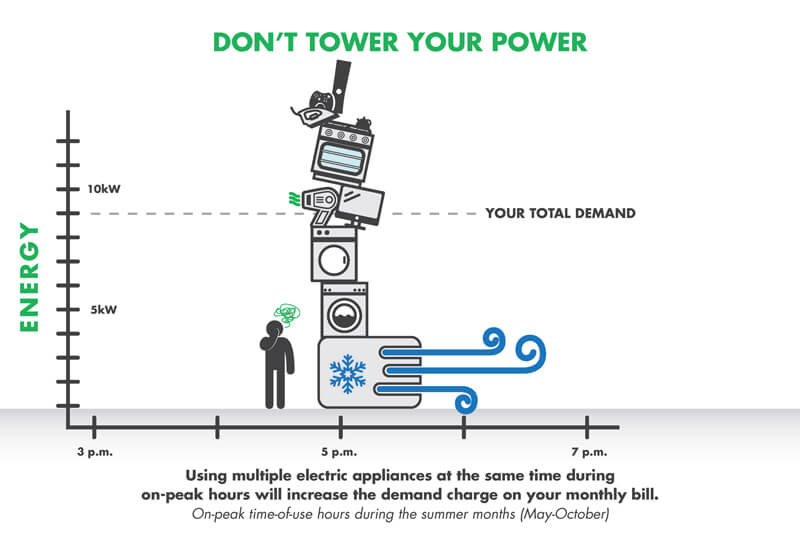
Demand Time-of-Use
Can you avoid using a lot of power during periods when people typically use energy the most? If so, our residential Demand Time-of-Use pricing plan might be right for you.
How does Demand Time-of-Use work?
This plan combines lower usage-based rates for most of the day with higher usage rates during on-peak hours. It also includes a monthly “demand” charge based on your highest hourly usage during on-peak hours. So if you can spread out your use of large electric appliances during lower-cost, off-peak hours, this plan gives you the power to reduce your monthly bill.
Under this plan, you could maximize your savings by avoiding the simultaneous use of your oven, clothes dryer, dishwasher and other large appliances during higher-cost, on-peak hours: 3-7 p.m. during the summer (May-October) and 6-9 a.m. and 6-9 p.m. during the winter (November-April).
With Demand Time-of-Use, timing is everything. The more you are able to even out and shift your usage away from peak hours, the better off you’ll be. Your savings will vary based on your usage patterns.
What are the potential advantages of this plan?
By adding a demand rate to the traditional time-of-use pricing structure, customers on the Demand Time-of-Use plan have even more opportunity to lower their energy costs by making smart choices about when they use energy.
UES’ service costs are driven by the need to satisfy customers’ highest demand, even if it only occurs once each month. When that maximum usage level goes down, so does the cost of providing all of our customers with safe, reliable service.
Our Demand Time-of-Use plan is designed to reward customers who do their part to reduce the peak demand on the electric grid during peak usage periods. Reducing the peak energy demand promotes more efficient use of our energy resources and can help limit future rate increases.
What are the potential disadvantages of this plan?
If you use a lot of power during on-peak hours, your energy costs could increase under our Demand Time-of-Use plan. That’s particularly true if your hourly demand reaches a high level even once per billing cycle. The higher Demand Charge that results from such usage reflects the cost of resources and facilities UES must build and maintain to satisfy even occasional needs during peak usage periods.
How can I shift my electric usage to off-peak time periods?
- Operate washing machines, clothes dryers, dishwashers and other large appliances during off-peak hours.
- Adjust your thermostat to reduce heating and cooling during on-peak hours or when you are not at home.
- Install timers on electric water heaters and recirculation pumps so they operate mainly during off-peak hours.
- Set timers on pool and spa pumps to run during off-peak hours.
- Turn off all but essential lights during on-peak hours.
- Enjoy electricity-consuming hobbies during the off-peak hours.
- If you have an electric vehicle, charge it during off-peak hours.
TIME-OF-USE HOURS
SUMMER: MaytoOctober
| Days | midnight to 3 p.m. | 3 to 7 p.m. | 7 p.m. to midnight |
|---|---|---|---|
| MONDAYtoFRIDAY | OFF-PEAK | ON-PEAK | OFF-PEAK |
| WEEKENDS & MAJOR HOLIDAYS | OFF-PEAK | ||
Major holidays include Memorial Day, Independence Day (July 4), and Labor Day. If Independence Day falls on Saturday, the weekend schedule applies on the preceding Friday, July 3. If Independence Day falls on Sunday, the weekend schedule applies on the following Monday, July 5. All weekends are off-peak.
WINTER: NovembertoApril
| Days | midnight to 6 a.m. | 6 to 9 a.m. | 9 a.m. to 6 p.m. | 6 to 9 p.m. | 9 p.m. to midnight |
|---|---|---|---|---|---|
| MONDAYto FRIDAY | OFF-PEAK | ON-PEAK | OFF-PEAK | ON-PEAK | Not applicable |
| WEEKENDS & MAJOR HOLIDAYS | OFF-PEAK | ||||
Major holidays include Thanksgiving Day, Christmas Day and New Year’s Day. If Christmas Day and New Year’s Day fall on Saturdays, the weekend schedule applies on the preceding Fridays, Dec. 24 and Dec. 31. If Christmas Day and New Year’s Day fall on Sundays, the weekend schedule applies on the following Mondays, Dec. 26 and Jan. 2. All weekends are off-peak.
¹ Includes Delivery Services-Energy and Base Power charges but excludes the Purchased Power and Fuel Adjustment Clause charge, which changes monthly.
² The greatest measured one-hour average during on-peak time-of-use hours of a billing period. In the summer (May-October), the on-peak period is 3-7 p.m., Monday through Friday (excluding Memorial Day, Independence Day and Memorial Day). In the winter (November-April), on-peak periods are 6-9 a.m. and 6-9 p.m., Monday through Friday (excluding Thanksgiving Day, Christmas Day and New Year’s Day.



